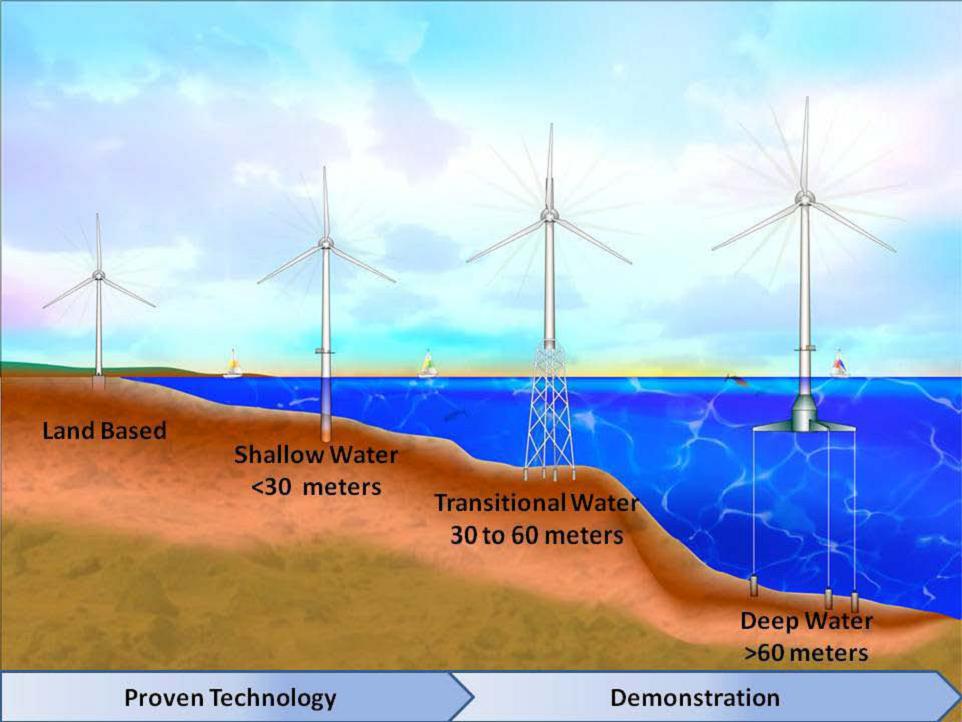
Photo Credit: U.S. Department of Energy. Photo located on flickr
With an increasing demand for alternative energy production, offshore wind has become a hot topic of discussion. For the last twenty years Germany, United Kingdom, and many other European countries have been leading the way for offshore wind production to meet energy demands. Quite recently, the United States constructed its first offshore wind farm, the Block Island Wind Farm, off the coast of Rhode Island.
With all of this offshore wind development one could surmise that the environment could be adversely affected…right?
To understand the potential environmental effects of offshore wind development, it is first important to understand how the wind farms are constructed and how they operate.
Construction and Operation

Offshore wind farms are constructed by pile-driving the sea floor to produce a foundation for installing the large metal structure that will hold the wind turbine. Because depths can reach over 100 feet, the metal structure is often cemented into the sea floor and rocks are sometimes piled up at the foundation to secure the structure.
Using Block Island Wind Farm as an example, turbines reach heights around 458 ft tall. To give some perspective, the Statue of Liberty is roughly 305 ft tall.
Block Island is a really small wind farm with only 5 turbines covering 2sq km. Whereas, Thanet Offshore Wind Farm has 100 turbines covering 35sq km.
Block Island took about one year from when construction started to operation but it can take years to construct a wind farm. Part of the reason is because the equipment is expensive and it depends on how many turbines are being installed.
Is It All Bad News?
It’s actually good news. Although marine biologists and environmental activists initially raised concerns about the possible negative effects offshore wind farms might have on migrating birds and marine mammals, research has shown that these effects are actually minimal and most likely short-term. Research shows that migratory birds actually alter their flight paths to avoid collision with wind turbines. Studies also suggest that the noise made during construction does not harm marine mammals ability to communicate or maneuver.
And not only are the effects minimal, but offshore wind farms may provide benefits to the surrounding environment.
You are probably wondering, “How can building an offshore wind farm be beneficial to the environment?” The answer is simple: artificial reefs.
What Are Artificial Reefs? And How Do Wind Farms Relate?
Artificial reefs are man-made structures such as sunken ships, bridges, or hard substrates that resemble reef-like ecosystems. Marine organisms, such as oysters, mussels, and other creatures, attach to these substrates.

Marine biologists have found that the foundations and structures constructed for offshore wind farms, once secured in the sea floor, produce an artificial reef effect after mussels and oysters attach to them. Different fishes and bottom feeders are then attracted to the structures because the mussels and oysters provide a food source as well as shelter.
Studies have shown that the artificial reef creation from wind farms attracts abundance of fishes, especially bottom feeders. Even more surprising is that these artificial reefs may provide a food source for apex predators. Not only do smaller fishes aggregate around the structures, but this could lead to attracting bigger species which, in turn, can impact the entire food chain.
For example, seals repeatedly frequent offshore wind farms in British waters because there are an abundance of fishes and invertebrates surrounding each structure. This means there is enough fishes and life in, as well as around offshore wind farms to support higher organisms on the food chain.
This is not only good news for the livelihoods of fishermen who fish near wind farms, but also for marine ecosystems. This is also good news for the United States as it starts developing more offshore wind farms.
What Is Happening Now?
Currently, the United States is considering expanding offshore wind off the northeast coast after the completion of the Block Island Wind Farm.
Block Island Wind Farm consists of 5 turbines which are secured in about 30 meters or about 100 feet in-depth at the sea floor. This is a smaller wind farm compared to one of the largest wind farms, the London Array, which has over 100 turbines covering 100sq km reaching depths up to 24 meters or 78 feet secured at the sea bottom.
Construction of a utility-scale wind farm called South Fork Wind Farm off the coast of Long Island is supposed to start around 2019 and will help provide clean energy for Long Island. This wind farm will have 15 turbines providing about 90MW capacity of energy. This is only the beginning for the potential development of offshore wind farms for the east coast in the United States.
Ultimately, using offshore wind instead of fossil fuels for power can help decrease the amount of carbon emissions released into the atmosphere which, as a result, can benefit natural reefs which are already being adversely impacted by carbon emissions. Offshore wind can also produce artificial reef effect, which can help offset the decreasing number of reefs across the globe.
Want More Information?
If you want to learn more about offshore wind farms and artificial reefs, here is some information to get you started:
NOAA Website: Florida Keys Artificial Reefs
Deepwater Wind Projects: Block Island
Information About Offshore Wind Farms Around The World
New York State Offshore Wind Master Plan
Offshore Wind Farms Create Artificial Reef Effect: Seals Benefit
